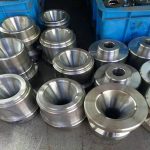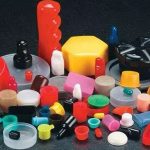According to the chemical composition of steel, it can be divided into two categories: carbon steel and alloy steel.
Carbon steel is divided into:
① low carbon steel, carbon content is less than 0.25%;
② medium carbon steel, carbon content is 0.25%-0.6%;
③ high carbon steel, carbon content is greater than 0.6%;
Mild steel is carbon steel with a carbon content of less than 0.25%. Because of its low strength, low hardness and softness, it is also called mild steel. It includes most ordinary carbon structural steels and some high-quality carbon structural steels. Most of them are used for engineering structural parts without heat treatment, and some are used for mechanical parts that require wear resistance after carburizing and other heat treatments.
The annealed structure of low carbon steel is ferrite and a small amount of pearlite, its strength and hardness are low, and its plasticity and toughness are better. Therefore, its cold forming is good, and it can be cold processed such as crimping, bending, stamping, drawing, etc.; it is easy to forging, welding and other hot processing. Due to the low carbon content of low carbon steel, the content of alloying elements Mn and Si is not high. In general, its weldability is good, and the structure will not be hardened due to the rapid cooling of the welding heat cycle, but the structure will become embrittlement. Therefore, generally the weldment with a thickness of less than 70mm does not need to be preheated before welding, and it is not necessary to maintain the interlayer temperature. However, except for important welded structures such as boilers and pressure vessels, it is still necessary to consider preheating and maintaining the interlayer temperature.
Low-carbon steel can be welded by almost all welding methods, which can guarantee the welding quality, such as: electrode arc welding, submerged arc welding, argon arc welding, secondary welding, flux-cored gas shielded welding, electroslag welding, plasma arc welding, Laser welding, resistance welding, friction welding, brazing, gas welding, etc. The most widely used low-carbon steel welding is electrode arc welding. The principle of selecting electrodes for low-carbon steel is the principle of equal strength. Generally, E43×× series electrodes are used, which can be selected according to the specific base material, load, environment, etc.;
Medium carbon steel has good hot working and cutting performance, but poor welding performance. Strength and hardness are higher than low carbon steel, while plasticity and toughness are lower than low carbon steel. It can be used directly without heat treatment, cold-rolled material, cold-drawn material, or after heat treatment. The quenched and tempered medium carbon steel has good comprehensive mechanical properties. The highest hardness that can be achieved is about HRC55 (HB538), and σb is 600~1100MPa. Therefore, among the various uses of medium strength level, medium carbon steel is the most widely used. In addition to being used as a building material, it is also widely used in the manufacture of various mechanical parts.
High Carbon Steel is often called tool steel, with a carbon content from 0.60% to 1.70%, can be quenched and tempered, and has poor welding performance. Hammers, crowbars, etc. are made of steel with a carbon content of 0.75%; cutting tools such as drills, taps, and reamers are made of steel with a carbon content of 0.90% to 1.00%.

Comparison of welding performance between low carbon steel and high carbon steel
The welding performance of steel mainly depends on its chemical composition. The most influential element is carbon, which means that the amount of carbon in a metal determines its weldability. Most of the other alloying elements in steel are also not conducive to welding, but their degree of influence is generally much smaller than that of carbon.
Generally, low-carbon steel has good weldability and generally does not need to adopt special process measures. It is only necessary to weld with alkaline electrodes when low temperature, thick plates or high requirements are required, and proper preheating. When the carbon and sulfur content of low-carbon steel is above the upper limit, in addition to the use of high-quality low-hydrogen welding rods, preheating and post-heating and other measures, the groove form should be reasonably selected and the fusion ratio should be reduced to prevent thermal cracks. .
The preparation of the carbon steel groove can be cold working or hot working. The welding groove should be kept flat and free of defects such as cracks, delamination and slag inclusion. Oil stains, rust, rust, etc. within 20-30mm on both sides of the groove Clean up harmful impurities such as slag and water. The welding rod is dried according to regulations.
If it is cold in winter, preheat 50~100℃ when welding thick parts and rigid structures. The tack welding of low carbon steel is the same as the welding consumables for normal welding. The tack weld must not have cracks, otherwise it must be re-welded; the two ends of the tack weld fused into the permanent weld should be made with gentle slopes for arc welding. Generally, the arc should be ignited in the arc ignition plate or groove, and the arc cannot be ignited at the non-welded part. The arc crater must be filled when the arc is extinguished. Every welding seam should be welded as much as possible at one time, and the welding interruption should be avoided as much as possible. For important components, the interlayer temperature should not exceed the specified range during welding; when the weldment is preheated, the interlayer temperature should be controlled not to be lower than the preheating temperature.
Galvanized steel sheet is one of the more difficult to weld in low carbon steel. The main reason is that the galvanized layer brings increased sensitivity to welding cracks and pores, zinc evaporation and smoke, oxide slag, and plating. The zinc layer is melted and destroyed. Low carbon steel galvanized steel sheet can be welded by manual arc welding, MIG welding, argon arc welding and resistance welding. For manual arc welding, the groove should be properly opened before welding, and the galvanized layer near the groove should be removed. The removal method can be flame baking or sandblasting.
The strength of the electrode should be as close as possible to the base metal. Generally, J421/J422/J423 electrodes are preferred; for galvanized steel sheets with strength levels above 500MPa, electrodes such as E5001/E5003 can be used; for galvanized steel sheets with strength above 600MPa, electrodes such as E6013/E5503/E5513 should be used. When welding, use a short arc as much as possible, do not swing, in order to prevent the expansion of the melting area of the galvanized layer, to ensure the corrosion resistance of the weldment and reduce the amount of smoke and dust.
Medium-carbon steel has a tendency to cold crack during welding. The higher the carbon content, the greater the hardening tendency of the heat-affected zone, the greater the tendency of cold cracking, and the worse the weldability. As the carbon content of the base metal increases, the carbon content of the weld metal will also increase accordingly. Coupled with the adverse effect of sulfur, it is easy to form hot cracks in the weld. Therefore, the welding of medium carbon steel should use alkaline electrodes with good crack resistance, and take preheating and postheating measures to reduce the tendency of cracks.
When welding high-carbon steel, due to the high carbon content of this steel, a large welding stress will be generated during welding. The hardening and cold cracking tendency of the welding heat-affected zone is greater, and the weld is also more prone to hot cracks. High-carbon steel is more prone to hot cracking than medium-carbon steel when welding, so this type of steel has the worst weldability, so it is not used in general welding structures and is only used for casting repair welding or surfacing. After welding, the weldment should be tempered to eliminate stress, fix the structure, prevent cracks and improve the performance of the weld.
Link to this article:Can all carbon steels be welded?
Reprint Statement: If there are no special instructions, all articles on this site are original. Please indicate the source for reprinting:https://www.cncmachiningptj.com/,thanks!
 3, 4 and 5-axis precision CNC machining services for aluminum machining, beryllium, carbon steel, magnesium, titanium machining, Inconel, platinum, superalloy, acetal, polycarbonate, fiberglass, graphite and wood. Capable of machining parts up to 98 in. turning dia. and +/-0.001 in. straightness tolerance. Processes include milling, turning, drilling, boring, threading, tapping, forming, knurling, counterboring, countersinking, reaming and laser cutting. Secondary services such as assembly, centerless grinding, heat treating, plating and welding. Prototype and low to high volume production offered with maximum 50,000 units. Suitable for fluid power, pneumatics, hydraulics and valve applications. Serves the aerospace, aircraft, military, medical and defense industries.PTJ will strategize with you to provide the most cost-effective services to help you reach your target,Welcome to Contact us ( [email protected] ) directly for your new project.
3, 4 and 5-axis precision CNC machining services for aluminum machining, beryllium, carbon steel, magnesium, titanium machining, Inconel, platinum, superalloy, acetal, polycarbonate, fiberglass, graphite and wood. Capable of machining parts up to 98 in. turning dia. and +/-0.001 in. straightness tolerance. Processes include milling, turning, drilling, boring, threading, tapping, forming, knurling, counterboring, countersinking, reaming and laser cutting. Secondary services such as assembly, centerless grinding, heat treating, plating and welding. Prototype and low to high volume production offered with maximum 50,000 units. Suitable for fluid power, pneumatics, hydraulics and valve applications. Serves the aerospace, aircraft, military, medical and defense industries.PTJ will strategize with you to provide the most cost-effective services to help you reach your target,Welcome to Contact us ( [email protected] ) directly for your new project.
Link to this article:Can all carbon steels be welded?
Reprint Statement: If there are no special instructions, all articles on this site are original. Please indicate the source for reprinting:Tungusten,Thanks!^^








